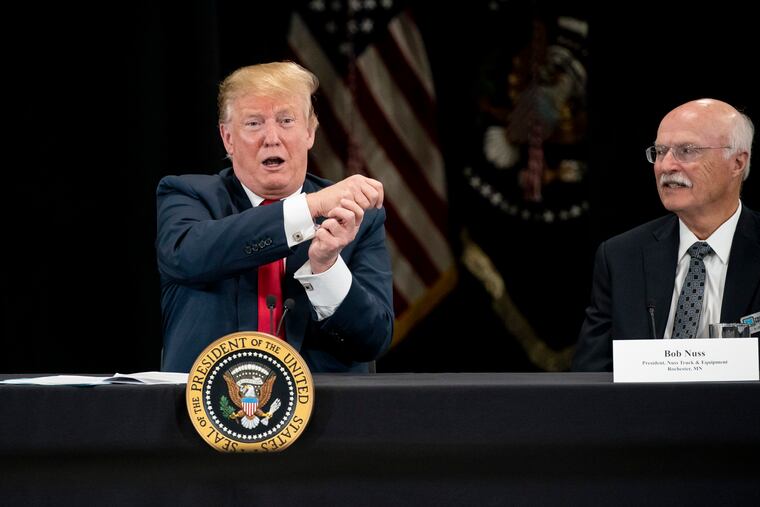Recession risks are uncomfortably rising as faith in the economy wanes
President Trump’s trade war is creating an increasing amount of angst, as it clearly could go very wrong.

If you are a reader of The Inquirer’s business pages or even a casual CNBC watcher, you have probably heard the R-word a lot lately. Yes, recession.
You may be a bit perplexed by this. After all, the unemployment rate is at a 50-year low, and there are a record number of open job positions in nearly every profession. The stock market is flirting with an all-time high. And come July 4th, the economy will have consistently grown for more than a decade, becoming the longest economic expansion in U.S. history.
It’s not just worry-wart economists who are fixated on a coming downturn; it is also many business executives and investors. So, what’s all the loud hand-wringing over recession about?
Driving the angst is the much slower economic growth. Some slowing this year was anticipated, as last year’s growth was temporarily juiced up by deficit-financed tax cuts to mostly wealthy individuals and large corporations. This fiscal stimulus has since faded away, and some ill effects of the tax cuts, including softer house price growth due to the scaling back of preferences in the tax code for homeownership, are playing out now.
But the economy feels more fragile than anticipated. The problem is President Donald Trump’s trade war. While the tariffs the president has actually imposed have been modest — 25 percent on $250 billion in Chinese imports to the U.S. and some steel and aluminum imports — his threats are anything but. Currently in play are 25 percent on the remaining $300 billion in Chinese imports and about $275 billion in vehicle imports.
Businesses appear spooked by the president’s capricious trade policy. Moody’s Analytics’ global business confidence survey, which asks respondents nine questions about their operations, is as weak as it has been since the economy began its ascent out of the financial crisis a decade ago. Duke University’s quarterly survey of CFOs is even more pessimistic, with about two-thirds of respondents saying a recession is likely by the end of 2020. And Morgan Stanley’s business conditions index, which is designed to capture turning points in the economy, suffered its largest one-month decline on record in May.
Recession angst is also evident among investors in Treasury bonds. Long-term Treasury yields have fallen sharply since last fall, as investors are strongly betting the Fed will lower the federal funds rate several times by the end of the year to ward off an even weaker economy.
The Treasury yield curve, as measured by the difference between 10-year and three-month Treasury yields, is firmly inverted. That is, 3-month yields are higher than 10-year yields. I won’t explain why, but this rarely happens and when it does it has presciently signaled a recession about a year later. The curve is not predicting recession yet, but it is awfully close.
It’s only consumers – that’s you – who remain seemingly oblivious to the possibility of recession, at least so far. Both the Conference Board and University of Michigan surveys of consumer sentiment are off their highs registered during this expansion, but they are still high by historical standards.
Recession will remain at bay as long as consumers stay upbeat and continue spending. However, consumer confidence is fickle and can evaporate quickly. Historically, all it has taken was a softer job market, with job growth slipping to a point where unemployment increased. It’s not that consumers vigilantly monitor the employment statistics, but they quickly sense the weaker job growth, the fewer number of open positions, and the mounting layoffs. It’s often not clear what causes consumers to hit the panic button, but when they do, sentiment falls sharply, and recession hits a few months later.
Recessions are the result of a collective loss of faith in the economic future. Everyone runs for the proverbial bunker to be sheltered from the coming economic storm, and by so doing, creates the storm. Investors generally lose faith first, selling stocks, real estate, and riskier bonds. Businesses follow, cutting investment, and ultimately pulling back on their payrolls. Consumers are generally the last to pack it in, but when they do, it happens quickly.
There are times when the collective psyche is more vulnerable than others, when a thin line separates the optimism that characterizes an expanding economy and the pessimism that pervades a downturn. This generally happens well into an economic expansion, when imbalances have developed — labor markets are overly tight, underwriting is too easy, leverage is high and liquidity weak, asset prices are overvalued, and real estate markets overbuilt. The line is crossed when something, almost anything, goes wrong.
This appears to be one of those times. Although the imbalances that undermine economic expansions are not fully evident today, faith in the economy is fragile. President Trump’s trade war is creating an increasing amount of angst, as it clearly could go very wrong. Recession risks are uncomfortably high.